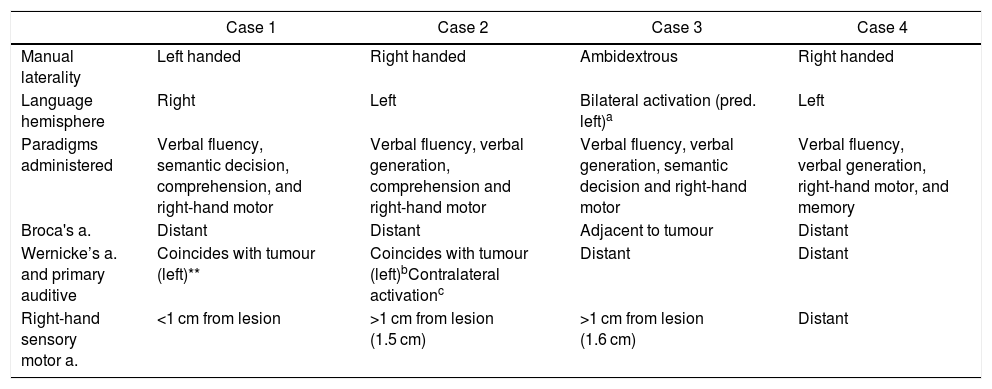Dysembryoplastic neuroepithelial tumours (DNET) are a type of benign glioneuronal neoplasia of typically temporal location that produce drug-resistant epileptic seizures in children and young adults.
AimsThis work aims to assess the usefulness of functional magnetic resonance imaging (fMRI) in the preoperative study in four patients with DNET. A Philips Intera 3.0 Tesla magnetic resonance imaging scanner and the Blood-Oxygen-Level-Dependent (BOLD) technique were used to obtain the images, making it possible to locate the eloquent areas for language and motor areas through the application of specific paradigms.
ResultsIn one case the tumour was adjacent to Broca’s area, in two cases it coincided with Wernicke’s area, in one patient it was <1 cm from the motor area for the hand and in another close to memory. Only two of the patients were operated on, without postoperative functional deficit. Hemispheric activation contralateral to the tumour suggestive of neuroplasticity was observed in one of the patients.
ConclusionsfMRI is a non-invasive method that allows us to assess the proximity of lesions to eloquent areas, which is key in the evaluation of surgical risk. In addition, it allowed the detection of probable neuroplasticity in one case, which guaranteed the success of the surgery
Los tumores neuroepiteliales disembrioplásicos (DNET) son un tipo de neoplasia glioneuronal benigna de localización típicamente temporal que producen crisis epilépticas resistentes a tratamiento farmacológico en niños y adultos jóvenes.
ObjetivoSe muestran cuatro casos valorando la utilidad de la resonancia magnética funcional (RMf) en el estudio prequirúrgico de pacientes con DNET. Para la obtención de imágenes se utilizó un equipo de resonancia magnética Philipps Intera de 3.0 Tesla y la técnica Blood Oxygenation Level-Dependent (BOLD), permitiendo localizar las áreas elocuentes de lenguaje y motora mediante la aplicación de paradigmas específicos.
ResultadosEn un caso el tumor se encontraba adyacente al área de Broca, en dos casos coincidía con Wernicke, en un paciente estaba a <1 cm del área motora de la mano y en otro próximo a la memoria. Sólo dos de los pacientes fueron operados, no produciéndose déficit funcional postoperatorio. Se observó activación hemisférica contralateral al tumor sugestivo de neuroplasticidad en uno de los pacientes.
ConclusionesLa RMf supone un método no invasivo que permite evaluar la proximidad de las lesiones a las áreas elocuentes, clave en la evaluación del riesgo quirúrgico. Además, ha permitido detectar probable neuroplasticidad en un caso, la cual ha garantizado el éxito de la cirugía.
Article

If it is the first time you have accessed you can obtain your credentials by contacting Elsevier Spain in suscripciones@elsevier.com or by calling our Customer Service at902 88 87 40 if you are calling from Spain or at +34 932 418 800 (from 9 to 18h., GMT + 1) if you are calling outside of Spain.
If you already have your login data, please click here .
If you have forgotten your password you can you can recover it by clicking here and selecting the option ¿I have forgotten my password¿.










